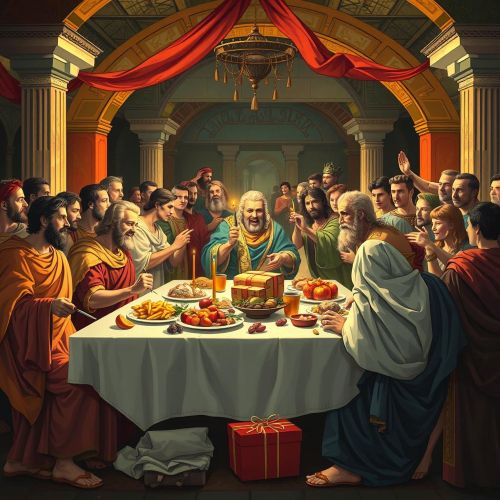Potlatch : Celebration of Generosity
At a glance
| Description | |
|---|---|
| Location | Pacific Northwest Coast of North America |
| Country | USA, Canada |
| Dedicated To | Dzunukwa |
| Duration | N/A |
| Time of Year | Winter |
Introduction
The Potlatch is a profound cultural institution observed by many Indigenous peoples of the Pacific Northwest Coast, such as the Haida, Tlingit, Kwakwaka’wakw, Nuu-chah-nulth, Tsimshian, and Coast Salish, among others. More than a simple gathering, it functioned historically as a socio-political and economic system. Derived from the Chinook Jargon term meaning “to give away,” the Potlatch is rooted in a philosophy of generosity, reciprocity, and honor. At its heart, this ceremony affirms leadership, forges alliances, and maintains social balance by redistributing wealth and validating hereditary rights. The practice bridges the material and the spiritual, symbolizing not only a host’s prestige but also their responsibility to uphold cultural continuity.
Connection with Mythology
Mythological narratives and spiritual reverence are deeply embedded within Potlatch traditions. Each ceremony is more than a performance—it is a cosmological reenactment. Among the Kwakwaka’wakw, sacred dances represent encounters with supernatural beings like Dzunukwa or the cannibal spirit Baxbaxwalanuksiwe. These characters are believed to be ancestors or powerful beings who once interacted with humans and passed on important teachings. By invoking them during the Potlatch, participants ensure that ancestral wisdom is carried forward.
In many tribes, dances and regalia embody ancient myths that link clans to mythical origins or animal totems. The Tlingit, for example, use songs and dramatic storytelling to affirm connections to Raven, Bear, or other figures from their oral traditions. These mythic tales are not merely retold—they are lived during the Potlatch. As a result, spiritual lineage and cosmic order are reaffirmed before the assembled community, making mythology a living part of the cultural and social structure.
Main Activities
The Potlatch is structured around a wide range of ceremonial and communal activities, each rich with symbolic meaning. Although the tone may vary between joyous celebration and solemn remembrance, the event often unfolds across several days with meticulous planning and precise protocol.
Gift Distribution: Central to the Potlatch is the act of giving. The host distributes food, blankets, tools, ceremonial items, and historically even slaves or copper plaques known as coppers. These gifts are not random; their distribution is based on the recipient’s rank and relationship to the host, reaffirming social hierarchies and networks of mutual obligation.
Feasting and Hospitality: Lavish feasts are prepared and shared with guests, symbolizing abundance and social wealth. Food items such as dried fish, oolichan grease, and berries are not just sustenance but hold cultural significance tied to specific territories and rights.
Dancing and Regalia: Dancers clad in carved masks and animal-hide regalia bring ancestral stories to life through complex choreography. These performances often reveal clan affiliations, spiritual powers, and initiations into secret societies like the Hamatsa.
Storytelling and Naming Ceremonies: Through speeches and oration, hosts recount their family’s lineage, ancestral deeds, and rights to land or titles. These narratives are considered binding, especially when witnessed by members of other communities. Children may be given new names or titles, marking transitions into different social roles.
Public Record Keeping: Every act during the Potlatch serves as a public record. The presence of witnesses is crucial, as they legitimize the transfers of names, crests, and privileges. Through this oral contract, the Potlatch serves as a living legal system.
Importance in Cultural History
The Potlatch holds immense historical significance, serving as the principal mechanism through which governance, economics, education, and justice were administered. Chiefs and families used Potlatches to establish claims to land, titles, and privileges. This institution replaced written laws and deeds with oral agreements, witnessed and remembered by the community.
When colonial authorities banned the Potlatch in 1885, declaring it incompatible with Christian values and economic productivity, it dealt a severe blow to Indigenous autonomy. Potlatch participants faced imprisonment, and regalia were confiscated. Yet, the practice endured underground, with villages like Kingcome Inlet becoming havens for secret ceremonies. The ban, lifted in 1951, is now widely recognized as a colonial attempt to suppress Indigenous identity.
Today, Potlatches have not only survived but have returned as powerful expressions of cultural pride and resistance. They serve as vital platforms for language revitalization, youth mentorship, and community healing, especially in the context of ongoing reconciliation efforts. In communities like the Haida and Kwakwaka’wakw, Potlatch governance continues to be a legitimate authority, functioning parallel to imposed colonial systems.
Need a place to stay? Book your hotel room now!
International Appeal
Anthropologically, the Potlatch has intrigued scholars worldwide due to its complexity and counterintuitive economic logic. Instead of accumulating wealth, prestige is earned through giving it away. This concept challenged early Western economic theories and captivated researchers like Franz Boas and Marcel Mauss.
Mauss’s influential essay The Gift (1925) used the Potlatch as a cornerstone example to describe gift economies where transactions are not purely economic but deeply social and spiritual. The Potlatch inspired comparisons to other ceremonial exchanges like the Kula ring in the Trobriand Islands or the Moka in Papua New Guinea. These systems all emphasize the moral obligations of reciprocity, competition, and honor.
The intellectual impact of the Potlatch extends beyond anthropology. It has influenced modern discussions around sustainability, redistribution, and even alternative economies. Its logic counters the accumulation-driven capitalism prevalent in much of the world and instead proposes a model where status comes from generosity, not hoarding.
One particularly striking example of the Potlatch’s global resonance comes from Franz Boas’s 1894 visit to the Pacific Northwest. Guided by George Hunt, a Kwakwaka’wakw ethnographer, Boas witnessed a Potlatch that profoundly altered his thinking about culture. He shifted from seeing culture as a linear evolution to recognizing its pluralistic, dynamic nature. This intellectual pivot helped birth the field of cultural relativism—a foundational concept in modern anthropology.
Source
Alexander, K. (n.d.). Potlach Ceremony of Native Americans – Legends of America. Retrieved from https://www.legendsofamerica.com/potlach-ceremony/
Britannica. (n.d.). Potlatch | Definition, Ceremony, & Facts – Britannica. Retrieved from https://www.britannica.com/topic/potlatch
Don Hitchcock. (1999-12-13). The Potlatch – First Nations of the Pacific Northwest – Don’s Maps. Retrieved from https://www.donsmaps.com/potlatch.html
Fiveable Inc. (n.d.). Potlatch ceremonies – (Intro to Native American Studies) – Fiveable. Retrieved from https://fiveable.me/key-terms/introduction-to-native-american-studies/potlatch-ceremonies
Johansen, D. O. (1967). Empire of the Columbia: A History of the Pacific Northwest. Harper & Row.
Kan, S. (1989). Cohorts, Generations, and their Culture: The Tlingit Potlatch in the 1980s. Anthropos: International Review of Anthropology and Linguistics, 84, 405–422.
Napilay, J. (2024-08-08). How Ancient Myths and Legends Reflect the Societal Values and … Retrieved from https://medium.com/@joshuanapilay/how-ancient-myths-and-legends-reflect-the-societal-values-and-beliefs-of-the-cultures-that-created-8dc3bb1a926e
Wikipedia. (n.d.). Potlatch – Wikipedia. Retrieved from https://en.wikipedia.org/wiki/Potlatch
Frequently Asked Questions
Lorem ipsum dolor sit amet, consectetur adipiscing?
Lorem ipsum dolor sit amet, consectetur adipiscing elit. Praesent convallis vestibulum justo, ac tincidunt nunc vehicula quis. Nullam id dolor quis orci malesuada feugiat. Curabitur aliquet libero at urna ullamcorper, ac ultricies nulla dapibus.
Lorem ipsum dolor sit amet, consectetur adipiscing?
Lorem ipsum dolor sit amet, consectetur adipiscing elit. Praesent convallis vestibulum justo, ac tincidunt nunc vehicula quis. Nullam id dolor quis orci malesuada feugiat. Curabitur aliquet libero at urna ullamcorper, ac ultricies nulla dapibus.
Lorem ipsum dolor sit amet, consectetur adipiscing?
Lorem ipsum dolor sit amet, consectetur adipiscing elit. Praesent convallis vestibulum justo, ac tincidunt nunc vehicula quis. Nullam id dolor quis orci malesuada feugiat. Curabitur aliquet libero at urna ullamcorper, ac ultricies nulla dapibus.
Lorem ipsum dolor sit amet, consectetur adipiscing?
Lorem ipsum dolor sit amet, consectetur adipiscing elit. Praesent convallis vestibulum justo, ac tincidunt nunc vehicula quis. Nullam id dolor quis orci malesuada feugiat. Curabitur aliquet libero at urna ullamcorper, ac ultricies nulla dapibus.
Lorem ipsum dolor sit amet, consectetur adipiscing?
Lorem ipsum dolor sit amet, consectetur adipiscing elit. Praesent convallis vestibulum justo, ac tincidunt nunc vehicula quis. Nullam id dolor quis orci malesuada feugiat. Curabitur aliquet libero at urna ullamcorper, ac ultricies nulla dapibus.








